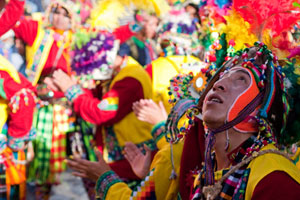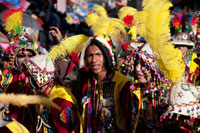 Tinku is a thousand-year-old ceremony that is held in the Andean regions of Bolivia (actually in the departments of Potosí and Oruro). The word Tinku means "meeting" in Quechua (the language descended from the Inca civilization that is still spoken in Bolivia). It comes from the verb Tinkuy, which means "to meet." In Aymara (the language descended from the Tihuanakota civilization) it means "physical attack." Back then, the Qaraqara kingdom flourished in this part of Bolivia. The Qaraqara warriors were famous and much feared for their practice in war, and when an important person arrived in the kingdom, a demonstration of their war skills was arranged.
Tinku is a thousand-year-old ceremony that is held in the Andean regions of Bolivia (actually in the departments of Potosí and Oruro). The word Tinku means "meeting" in Quechua (the language descended from the Inca civilization that is still spoken in Bolivia). It comes from the verb Tinkuy, which means "to meet." In Aymara (the language descended from the Tihuanakota civilization) it means "physical attack." Back then, the Qaraqara kingdom flourished in this part of Bolivia. The Qaraqara warriors were famous and much feared for their practice in war, and when an important person arrived in the kingdom, a demonstration of their war skills was arranged.
Macha was then the most populous city in the region, and everything points to the fact that the Tinku ritual got its start there, since the warriors meet to demonstrate their war skills. When the Incan Empire colonized the region, the emperor wanted his personal guards to come from the Qaraqara warriors. A battle was organized, and the winners were recruited as the Inca Emperor's guards.
Over time, the demonstration of war techniques also became a religious ceremony, the objective of which was to offer the blood of men to Mother Earth, or Pachamama, for a good harvest. The community that won the battle dominated the region throughout the year. The Andean Altiplano is dry, and water is scarce, so different communities continuously fought for access to the river in order to make their crops grow. The community that won the Tinku ritual battle had access to the river for the year.
This conflict for access to the river or domination in the region has always led to deaths and has left many children orphans, including one Chocomani Francisco who told us his story. He explained that when Evo Morales Ayma came into power in 2008, a sensitization project was organized to stop the war between communities. The President is of indigenous origin, so he wanted Bolivia's indigenous communities to behave as brothers and not as enemies. The representatives of each community in the region where Tinku was practiced were brought to the city of Cochabamba in another region of Bolivia. They participated and contributed their ideas for the sensitization project in order to transmit the government's message to their respective communities and to achieve peace among the clans. The most difficult challenge today, as Francisco explained to us, is to convince the orphans not to avenge the death of their parents.
Evolution of the Tinku ritual:
Today the Tinku ritual is carried out on May 3rd, the Lord of the Cross Catholic festival. The Spanish introduced an outside element into the ceremony that did not escape religious syncretism that is ever present in Latin America today. On that day, Jesus is dressed with a poncho and a whip, symbol of indigenous authority.
 In recent years, the ceremony has become a tourist event, and the police are present at the confrontations to avoid deaths. However, if no one dies, the clans believe that the harvest for the year will be bad because the offering to the Pachamama is not good enough. So we can see that Tinku is also a battle between the western viewpoint regarding human rights and Andean cosmovision of exchange between Mother Earth and mankind. Using the stone lance and whip is not permitted nowadays, and its use is punished by a fine. However, the communities that practice Tinku in remote areas are not controlled by the police, and it is likely that traditional weapons are used in some ceremonies.
In recent years, the ceremony has become a tourist event, and the police are present at the confrontations to avoid deaths. However, if no one dies, the clans believe that the harvest for the year will be bad because the offering to the Pachamama is not good enough. So we can see that Tinku is also a battle between the western viewpoint regarding human rights and Andean cosmovision of exchange between Mother Earth and mankind. Using the stone lance and whip is not permitted nowadays, and its use is punished by a fine. However, the communities that practice Tinku in remote areas are not controlled by the police, and it is likely that traditional weapons are used in some ceremonies.
Lately, the Tinku dance has become popular, and it is performed in the main urban parades and the carnival of Oruro. However, the people in the parades are young and come from the middle class in the urbanized areas who do not belong to the traditional Tinku communities. These parades are accompanied by brass bands and not by Tinku instruments, which are the charango, a small Andean guitar, and wooden wind instruments.
Today's Tinku:
Nowadays, the Tinku ritual takes place on May 2nd and 3rd every year. The different clans that participate in the ceremony meet at Macha for the most important ceremony. Since Tinku is practiced in southern Oruro and northern Potosí, other clans carry out the same ritual in their communities due to the distances, but also because the participants do not appreciate the presence of outsiders during the ceremony, whether they be Bolivian or foreigners.
The participants meet on May 2nd in the evening, and all the communities get together to dance and celebrate, drinking the corn liquor called chicha. Each group dances and parades, and the celebration lasts all night. Men play traditional music, and the women sing in Quechua in very high-pitched tones.
The confrontations begin on the following day, May 3rd, and both men and women participate. The fights take place between two people, one body against the other. Women, when they are not fighting, encourage the fighters and take care of the wounds. During the night following the confrontations, the fighters wash everything up, and the plaza is clean and deserted the following day.
We can thus conclude that Tinku is a small word that actually includes both a millennial tradition of a demonstration of force and an offering to the Pachamama, while it is also a conflict of power between communities in the region, and finally an expression of Bolivia's religious and cultural syncretism.
Sources:
https://www.tinkus.net
https://www.pieb.org/tinkuoruro/articulos.htm
Interview with Francisco Chocamani, a community resident in the Challapata region, one of the communities that practices Tinku.


